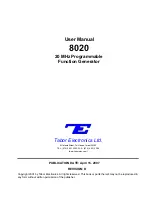
DCA15SPXU4F • OPERATION MANUAL — REV. #1 (02/10/17) — PAGE 13
INSTALLATION
OUTDOOR INSTALLATION
Install the generator in a area that is free of debris,
bystanders, and overhead obstructions. Make sure the
generator is on secure level ground so that it cannot slide
or shift around. Also install the generator in a manner so
that the exhaust will not be discharged in the direction of
nearby homes.
The installation site must be relatively free from moisture
and dust. All electrical equipment should be protected from
excessive moisture. Failure to do will result in deterioration
of the insulation and will result in short circuits and
grounding.
Foreign materials such as dust, sand, lint and abrasive
materials have a tendency to cause excessive wear to
engine and alternator parts.
INDOOR INSTALLATION
Exhaust gases from diesel engines are extremely
poisonous. Whenever an engine is installed indoors the
exhaust fumes must be vented to the outside. The engine
should be installed at least two feet from any outside wall.
Using an exhaust pipe which is too long or too small can
cause excessive back pressure which will cause the engine
to heat excessively and possibly burn the valves.
CAUTION
Pay close attention to ventilation when operating the
generator inside tunnels and caves. The engine exhaust
contains noxious elements. Engine exhaust must be
routed to a ventilated area.
NOTICE
Applying a large load to the generator during the initial
start up (large amounts of carbon deposits in the
exhaust system) may create sparks that can start fires
and may cause abnormal combustion. Therefore,
apply
load gradually
and observe the exhaust gas color..
MOUNTING
The generator must be mounted on a solid foundation (such
as concrete) and set firmly on the foundation to isolate
vibration of the generator when it is running. The generator
must set at least 6 inches above the floor or grade level (in
accordance to NFPA 110, Chapter 5-4.1).
DO NOT
remove
the metal skids on the bottom of the generator. They are
to resist damage to the bottom of the generator and to
maintain alignment.
GENERATOR GROUNDING
To guard against electrical shock and possible damage to
the equipment, it is important to provide a good
EARTH
ground (Figure 2).
Article 250 (Grounding) of the National Electrical Code
(NEC) provides guide lines for proper grounding and
specifies that the cable ground shall be connected to the
grounding system of the building as close to the point of
cable entry as practical.
NEC articles 250-64(b) and 250-66 set the following
grounding requirements:
1. Use one of the following wire types to connect the
generator to earth ground.
a. Copper - 8 AWG (5.3 mm
2
)
b. Aluminum - 6 AWG (8.4 mm
2
)
2. When grounding the generator (Figure 2) connect the
ground cable between the lock washer and the nut on
the generator and tighten the nut fully. Connect the
other end of the ground cable to earth ground.
3. NEC article 250-52(c) specifies that the earth ground rod
should be buried a minimum of 8 ft. into the ground.
NOTICE
When connecting the generator to any buildings
electrical system
ALWAYS
consult with a licensed
electrician.
NOTICE
This generator has a permanent bonding conductor
between the generator stator windings and the frame.
Summary of Contents for WHISPERWATT Series
Page 38: ...PAGE 38 DCA15SPXU4F OPERATION MANUAL REV 1 02 10 17 GENERATOR WIRING DIAGRAM ...
Page 39: ...DCA15SPXU4F OPERATION MANUAL REV 1 02 10 17 PAGE 39 ENGINE WIRING DIAGRAM ...
Page 40: ...PAGE 40 DCA15SPXU4F OPERATION MANUAL REV 1 02 10 17 BATTERY CHARGER WIRING DIAGRAM ...
Page 41: ...DCA15SPXU4F OPERATION MANUAL REV 1 02 10 17 PAGE 41 ENGINE BLOCK HEATER WIRING DIAGRAM ...














































